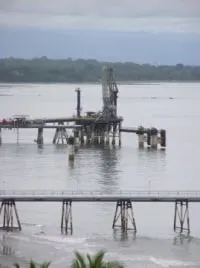Petro Terminal Panama pipe dreams become a reality.
Petro terminal Panama, in Puerto Armuelles, is set to become one of the most important facilities on the Pacific coast.

Petro terminal Panama, in Puerto Armuelles, is set to become one of the most important facilities on the Pacific coast.

Petro Terminal Panama is found about 3.5 miles south of the city of Puerto Armuelles on the Punta Burica peninsular. Originally built to pump surplus Alaskan crude oil across Panama for transshipment to refineries in Houston Texas. An agreement between the Bernstein brothers and the Governnment of Panama in 1977 started the ball rolling. A second agreement to build an oil pipeline between the two oceans began in 1980.
The two terminals are designed to handle crude and other similar products derived from petroleum. Additionally, the operations of blending, transshipment and/or transport of products through Isthmus of the Pacific Coast to the Atlantic Coast are done via a 131 kilometer pipeline.

Wharf number One at Charco Azul bay can handle tankers up to 310.000 DWT. The pumping capacity of the PTP terminals is awesome. Berth number one can pump 100,000 barrels of oil per hour – or put another way, they could fill up about 200,000 cars in the time it takes to eat lunch. Using centrifugal booster pumps they can also load at a rate of 40,000 b.p.h.

The oil is first pumped in a 40 inch pipe until it reaches a second pumping station in Caldera. Then a 36 inch pipe continues until it reaches the storage tanks at Chiriqui Grande on the Atlantic side of Panama. In its heyday the PTP operation hired up to 700 workers. Sadly dreams can turn into nightmares. For PTP that happened not in the calm clear waters of the central Pacific but thousands of miles away in the frigid waters of Alaska. March the 24th 1989 was the day when the Exxon Valdez ran aground.
By 1996 operations at PTP came to a standstill. At times the employment roll at Charco Azul was reduced to just one maintenance person. In November of 2003, the dream re-awakened when crude began flowing again, this time from Ecuador.
This week I visited the PTP terminal and talked to supervisor Julián J. Luque. The mood on this sunny day was optimistic as early that morning the Panamanian Energy minister had confirmed the long awaited refinery was going to be built. Julián made it clear the refinery and PTP are two completely separate entities. But logically, some interaction is almost inevitable. PTP has the offloading berths and pumping and storage equipment. The new refinery will be built somewhere south of PTP.
Julián said that VISITORS are not normally welcome, as this is a working facility and of obvious strategic importance. I had to commend him on the pristine layout of the complex. The well manicured lawns and palm fringed beaches look like something out of a high-end hotel resort, not a place where black gold is pumped and stored. Julián assured me that all possible environmental problems can be handled. In the event of a spill PTP has clean-up supplies stored ready for use and they have contingency plans to handle any ship-borne disasters.

PTP is a major thermal energy producer in Panama. Its plant at Puerto Armuelles produces 20 megawatts of power. How much power is that? A lot if you consider that towns such as Volcan and Boquete use only 1.5 megawatts. I doubt if the residents of Bocas del Toro realize but PTP keeps their lights and air conditioning running. PTP’s 4 megawatt plant at Isla Colon supplies, Colon, Carenero, Bastimento and Solarte islands.

The future of PTP grows rosier with each passing day. The international price of oil has passed $140 a barrel and there is the possibility the pipeline could do something unique. Initially the idea was for oil to be pumped from west to east, But Julián Luque assures me that technically they could pump in the opposite direction. This means that oil from countries such as Venezuela could be pumped to the Pacific side. The boom and bust cycle of Puerto Armuelles is clearly started back on an upward slope.
Panama is known internationally as the pathway between the oceans. Few realize that is has another pathway – a 40 inch steel pathway, that is almost the equal of its waterfilled brother.